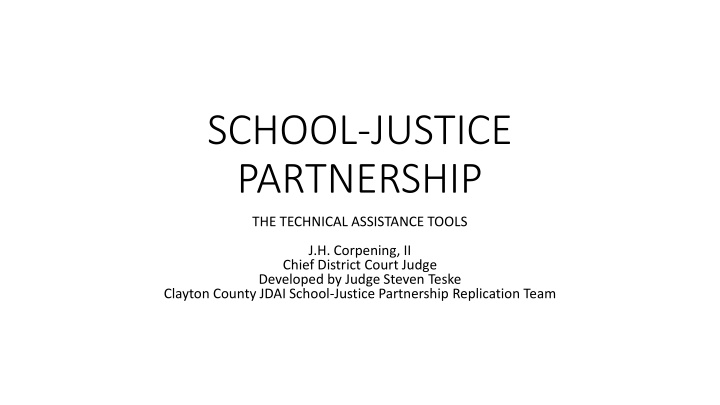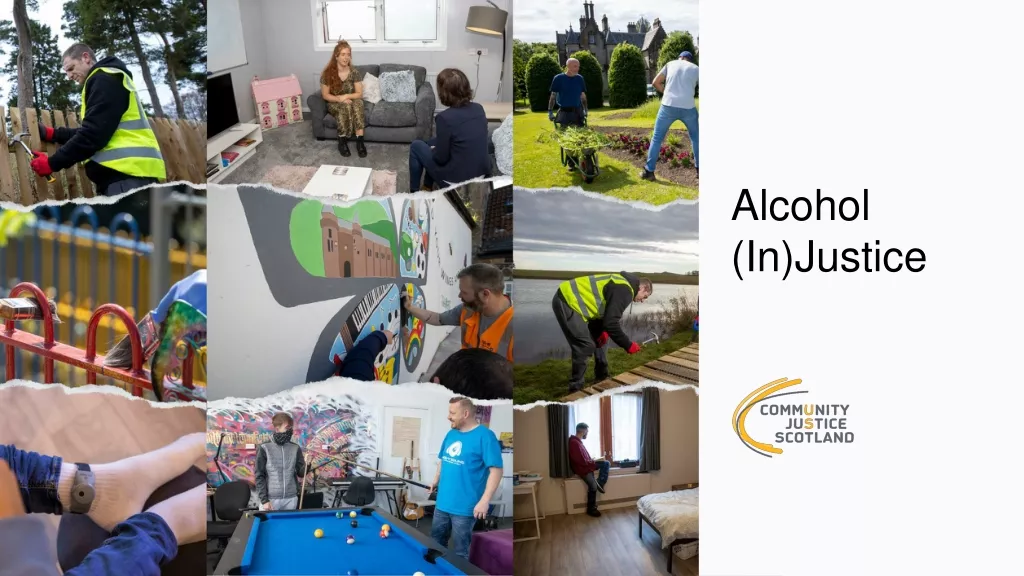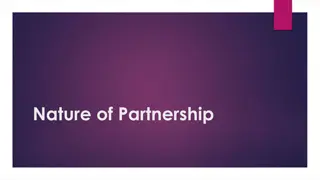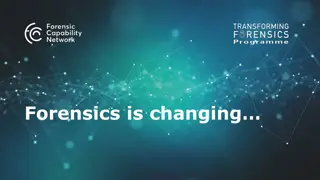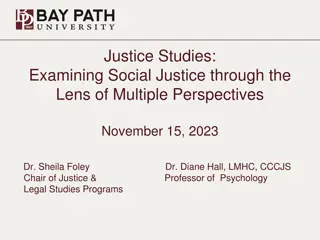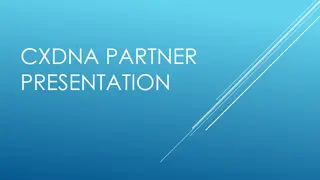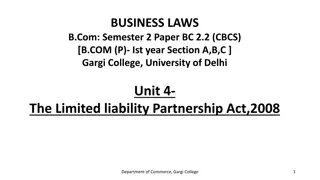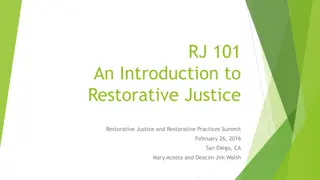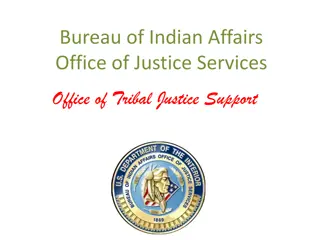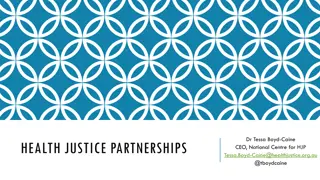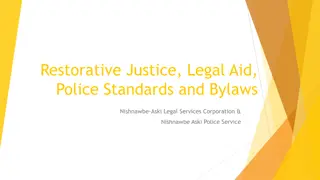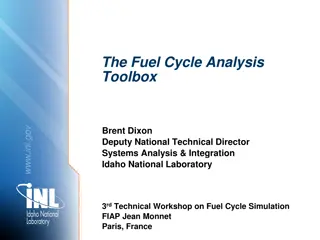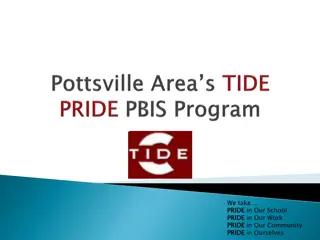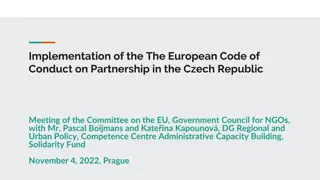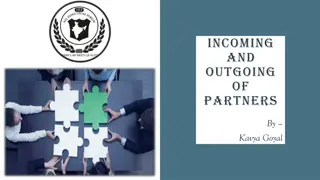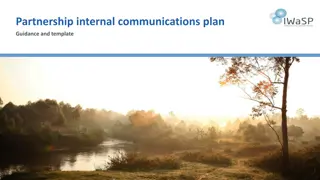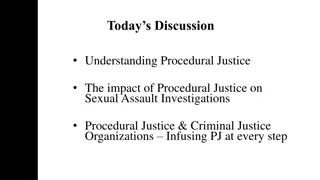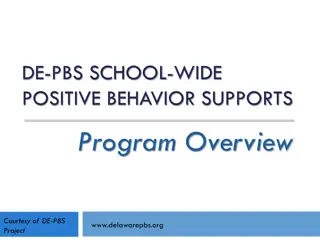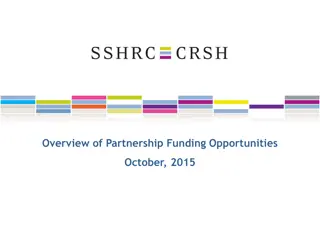School-Justice Partnership Tools for Positive Outcomes
This content outlines the development of a School-Justice Partnership program aimed at reducing school-based court referrals and implementing a graduated response program. It discusses the shared vision for change, key stakeholders involved, research supporting the initiative, strategies for accomplishing the goal, and collaborative steps to achieve positive outcomes in the school and community.
Download Presentation

Please find below an Image/Link to download the presentation.
The content on the website is provided AS IS for your information and personal use only. It may not be sold, licensed, or shared on other websites without obtaining consent from the author.If you encounter any issues during the download, it is possible that the publisher has removed the file from their server.
You are allowed to download the files provided on this website for personal or commercial use, subject to the condition that they are used lawfully. All files are the property of their respective owners.
The content on the website is provided AS IS for your information and personal use only. It may not be sold, licensed, or shared on other websites without obtaining consent from the author.
E N D
Presentation Transcript
SCHOOL-JUSTICE PARTNERSHIP THE TECHNICAL ASSISTANCE TOOLS J.H. Corpening, II Chief District Court Judge Developed by Judge Steven Teske Clayton County JDAI School-Justice Partnership Replication Team
WHY REDUCE SCHOOL-BASED REFERRALS TO THE COURT? (List the positive outcomes associated with reducing school-based court referrals & replacing with a graduated response program) COMMON AGENDA: WHAT IS THE SHARED VISION FOR CHANGE? (The group will develop a statement that describes the problem, goals, and the collective vision for solving it. Example: Keeping Kids in School, Out of Court, and on to a positive healthy future) WHO ARE THE PARTNERS/STAKEHOLDERS? (List the public and private organizations who can contribute to achieving the common goal and common agenda) GOAL: REDUCE SCHOOL-BASED REFERRALS TO COURT BY DEVELOPING A GRADUATED RESPONSE PROGRAM WHAT SUPPORTS THE WHY? (List the research, studies, and other evidence that shows that a School-Justice Partnership to reduce school referrals to court is positive for students, schools, and the community) HOW WILL THE PARTNERS ACCOMPLISH THE GOAL? (List the strategies and techniques used by others to achieve the common agenda) WHAT IS YOUR NAME? (The group will create a name for the collaborative if one has not been created. Example: School-Justice Partnership)
FOCUS ACTS COLLECTIVE IMPACT SYSTEM STAKEHOLDERS What school related offenses are we not going to refer to the court? How will we create an independent backbone agency of public and private stakeholders to support the school system? Who will decide the terms of the agreement & what will be the process for gathering input from interested stakeholders? Identify school related offenses for alternatives to arrest/referral using the Focus Act Decision Tree Exceptions, if any, that do not swallow the rule Identify Board of Directors; Draft By-Laws & Mission/Vision; Identify Funding streams; Create operational staffing Develop plan to bridge school & providers What approach? Who are the members? Who is the convener? Who is the facilitator? Who can provide support? POST AGREEMENT WORK BRIDGING (Immediate & Long Range Goals) IDENTIFY RESPONSES How will we respond to students nonresponsive to our accountability measures caused by trauma or observable underlying causation? What accountability measures do we have or can acquire in response to the Focus Acts? GOAL Reduce school arrests and referrals to the court Develop list of responses to the Focus Acts using the Resource Development Decision tree Direct referral to other agency; Single Point of Entry; Funding Collective Impact Model INTERAGENCY AGREEMENT GRADUATED RESPONSES QUALITY CONTROL How and when will we memorialize our action plan decisions for operational compliance and sustainability? When does it become necessary to refer a student to the court? How are we going to monitor intake of referrals for MOU compliance and to measure performance and outcomes? Match the Focus Acts to identified responses using Graduated Response Matrix What performance & outcomes are collected and measured? Who collects and measures? Periodic review Training Who will be drafting for circulation? When is target date for execution? How will the MOU be marketed?
ACTION STEP ONE: STAKEHOLDER GROUP GOAL: GOAL: Who will decide the terms of the agreement, how will we gather input from interested stakeholders, and what will we call this group? STEPS WHO DEADLINE 1. Identify the stakeholder approach (Who votes v. who advises) 2. Identify Common Agenda (Mission: Keeping Kids in School, Out of Court, and . . .) 2. Identify the stakeholders and their roles according to the approach (This may include those providing a supporting role e.g. assist convener, identify meeting place and time, etc) 3. Create a name for the group. 4. Identify the convener(s). 5. Identify the facilitator.
ACTION STEP TWO: FOCUS ACTS ACTION STEP TWO: FOCUS ACTS GOAL: GOAL: What What school related offenses are we not going to refer to the court? school related offenses are we not going to refer to the court? STEPS WHO DEADLINE 1. Identify school related offenses for alternatives to arrest/referral using the Focus Act Decision Tree 2. Exceptions, if any, that do not swallow the rule. 3. Develop clear guidelines defining the role of police on campus using the Role Conflict Avoidance Decision-Tree
ACTION STEP THREE: IDENTIFY RESPONSES ACTION STEP THREE: IDENTIFY RESPONSES GOAL: GOAL: What Focus Acts? Focus Acts? What accountability measures do we have or can acquire in response to the accountability measures do we have or can acquire in response to the STEPS WHO DEADLINE 1. Develop list of responses to the Focus Acts using the Focus Act Response Matrix
ACTION STEP FOUR: GRADUATED ACTION STEP FOUR: GRADUATED RESPONSES RESPONSES GOAL: GOAL: When do When do we refer a student to the court? we refer a student to the court? STEPS WHO DEADLINE 1. Using the Graduated Response Decision Tree as a guide, develop a Graduated Response Matrix
ACTION STEP FIVE: QUALITY CONTROL How are we going to monitor intake of referrals for MOU compliance and to measure performance and outcomes? STEPS WHO DEADLINE 1. What performance & Outcomes will be measured? 2. What Data will be collected? 3. Who Collects the data and measures performance and outcomes? 4. Who provides oversight to ensure daily compliance? 5. How often will group review status of protocol? 6. Who provides training and how often?
ACTION STEP SIX: INTERAGENCY AGREEMENT How and when will we memorialize our decisions for operational compliance and sustainability? STEPS WHO DEADLINE 1. Who will draft the MOU for circulation? 2. What is the date for execution? 3. How will the MOU be marketed?
ACTION STEP SEVEN: BRIDGING (Post-Agreement Work) GOAL: GOAL: How How will we respond to students nonresponsive will we respond to students nonresponsive traditional responses and require clinical type or other involved services? type or other involved services? traditional responses and require clinical STEPS WHO DEADLINE 1. Develop direct referral system to other agencies.. 2. Create Single Point of Entry; and 3. Identify funding streams 4. Develop Independent Backbone Agency optional)
ACTION STEP EIGHT: COLLECTIVE IMPACT SYSTEM G GOAL: OAL: How How will we create an independent backbone agency of public and private will we create an independent backbone agency of public and private stakeholders to support the school system? stakeholders to support the school system? STEPS WHO DEADLINE 1. Identify Board of Directors 2. Draft By-Laws & Mission/Vision 3. Identify Funding streams 4. Create operational staffing 5. Develop plan to bridge school & providers
SCHOOL-JUSTICE GOVERNANCE DECISION-TREE Will voting and non-voting members meet together? Use Unified Stakeholder Model Identify voting members Is there an existing collaborative? YES NO Identify the Stakeholders NO Have all Create name for the Collaborative and develop Common Agenda Use stakeholders unique to a School-Justice Partnership been identified? NO Bifurcated Stakeholder Model YES School-Justice Partnership
MODEL A: UNIFIED STAKEHOLDERS APPROACH SCHOOL-JUSTICE PARTNERS (Schools, Courts, JJ agency, LE, DA, PD) D VOTING MEMBERS ADVISORY MEMBERS UNIFIED STAKEHOLDERS APPROACH PUBLIC AGENCIES (Social Services, MH, Health, etc) (?) Rule One: School-Justice Partners responsible for school, law enforcement, and court decision-making are mandatory voting members; (?) LOCAL GOVERNMENT (Executive/Legislative) PRIVATE PROVIDERS (local service providers) Rule Two: May include those providing financial or in-kind support with voting authority; PARENTS/YOUTH (PTA,PTSA, Student Representative) Rule Three: All others are advisory members; and FAITH-BASED Rule Four: School-Justice voting members may veto decisions contrary to regulations or the law (unless subsequently changed by the proper authority). ADVOCATES (Focus: Youth, Teachers, Parents, Race/Ethnicity, Special Needs, etc) BUSINESS (Chamber of Commerce & Local Business)
COMMUNITY FORUM PARENTS YOUTH FAITH BASED ADVOCATES (Youth, Race, Other) BUSINESS OTHERS Bifurcated Stakeholder Group SCHOOL-JUSTICE STAKEHOLDER S SCHOOLS COURTS LAW ENFORCEMENT PROSECUTOR DEFENDER OTHERS SUBJECT MATTER FORUM SOCIAL SERVICES MENTAL HEALTH PRIVATE PROVIDERS LOCAL GOVERNMENT CHAMBER OF COMMERCE OTHERS SCHOOL-JUSTICE AGREEMENT
FOCUS ACT DECISION TREE MEMORANDUM OF UNDERSTANDING What offenses have occurred on your campuses? Will the offense be diverted from a formal petition? YES FOCUS ACT NO YES Once in court, is it more Are there mitigating circumstances that can be separated from aggravating circumstances? YES probable than not the judge will divert or informally adjust the case? NO NO REFERRAL TO COURT
FOCUS ACT DECISION TREE WORKSHEET MEMORANDUM OF UNDERSTANDING What offenses have occurred on your campuses? Diverted at Intake: Focus Acts: YES NO YES Diverted by Judge: Mitigating Circumstances: YES NO NO REFERRAL TO COURT
Role Conflict Avoidance Decision-Tree Delinquent School Resource Officer Involved? YES Is the conduct delinquent or a school infraction? Is it a Focus Act? NO Infraction Can it be resolved using problem- oriented approach? No Law Enforcement Involvement Response applied by School Resource Officer as set forth in Graduated Response Matrix This decision-tree is designed to aid school-justice partnerships with developing written guidelines that clearly distinguish the role of school police and school administrators to avoid role conflict that results in the unintended criminalizing of school rules. This process also aids in developing least restrictive responses when the infraction is delinquent in nature. As suggested in this process, SRO s should be given discretion at every decision point to resolve delinquent acts using a problem-solving model if possible. School Code Responses applied by Administrator Referral to Juvenile Court
Focus Act Response Matrix List Focus Acts: ACTS Person Inappropriate Touching Weapon Property Public Order Drugs Other TYPE RESPONSES
Graduated Response Decision Tree SECOND ACT FIRST ACT THIRD ACT NO Does the type of act require restitution, drug assessment, TX, or other response? YES Is a Graduated Response necessary? Is a referral to court necessary? NO NO YES YES Match response to act using Response Matrix WRITTEN WARNING COMPLAINT Best practice requires that a response process engage the decision-maker at every decision point to ask what response can be narrowly tailored (least restrictive) to achieve the desired outcome (modify behavior)
SCHOOL-JUSTICE AGREEMENT DECISION TREE COMPONENT PURPOSE GOALS/CONDITIONS 1.The Research: What works in school discipline; 2.The Law: What supports doing this? Interagency agreements Restorative Justice Diversion Delinquency/Status/Depend ency prevention Promote Graduation Coordination of Services Other 3.Existing agreements in support of School-Justice Initiative (Ex. School Based Probation) COMPONENT PURPOSE GOALS/CONDITIONS Why an agreement? Preamble or Introduction Data Collection Who collects it? How is it collected? How is it used? How is it reported? Periodic quality control meetings Who attends? How often? What are the Performance measures? What are the outcome measures? What is the process for modifications? Who & How on implementation & oversight 1.Focus Acts (See Focus Act Decision Tree) 2.Felony vs Misdemeanor 3.Student/Juvenile 4.Delinquent/Status/Dependent 5.IDEA/IEP 6.Diversion/Adjustment 7.Term or phrase describing the response to the Focus Act (Ex. Graduated Response Grid or System) Quality Control What terms need definition Definitions 1.Role of the SRO/LE 2.Prerequisites to referring to court What is the general rule? What are the exceptions (Exigent Circumstances) Response System: Graduated system with high, medium low? What are the responses associated to each level? 3.Special Cases IEP students Chronically disruptive: Referral for assessment & Treatment What does referral process look like (backbone agency, collaborative, etc) Probation Bullies 4.Treatment of Elementary Students INTER-AGENCY AGREEMENT/MOU How to operationalize the MOU Terms of Agreement FOLLOW TO NEXT PAGE
